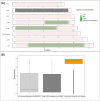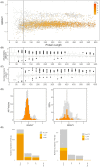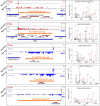Hidden in plain sight: challenges in proteomics detection of small ORF-encoded polypeptides
- PMID: 37223358
- PMCID: PMC10117744
- DOI: 10.1093/femsml/uqac005
Hidden in plain sight: challenges in proteomics detection of small ORF-encoded polypeptides
Abstract
Genomic studies of bacteria have long pointed toward widespread prevalence of small open reading frames (sORFs) encoding for short proteins, <100 amino acids in length. Despite the mounting genomic evidence of their robust expression, relatively little progress has been made in their mass spectrometry-based detection and various blanket statements have been used to explain this observed discrepancy. In this study, we provide a large-scale riboproteogenomics investigation of the challenging nature of proteomic detection of such small proteins as informed by conditional translation data. A panel of physiochemical properties alongside recently developed mass spectrometry detectability metrics was interrogated to provide a comprehensive evidence-based assessment of sORF-encoded polypeptide (SEP) detectability. Moreover, a large-scale proteomics and translatomics compendium of proteins produced by Salmonella Typhimurium (S. Typhimurium), a model human pathogen, across a panel of growth conditions is presented and used in support of our in silico SEP detectability analysis. This integrative approach is used to provide a data-driven census of small proteins expressed by S. Typhimurium across growth phases and infection-relevant conditions. Taken together, our study pinpoints current limitations in proteomics-based detection of novel small proteins currently missing from bacterial genome annotations.
Keywords: Salmonella Typhimurium; in silico proteomics; proteomics; riboproteogenomics; sORF; sORF-encoded polypeptides (SEPs).
© The Author(s) 2022. Published by Oxford University Press on behalf of FEMS.
Figures







Similar articles
-
Exposing the small protein load of bacterial life.FEMS Microbiol Rev. 2023 Nov 1;47(6):fuad063. doi: 10.1093/femsre/fuad063. FEMS Microbiol Rev. 2023. PMID: 38012116 Free PMC article. Review.
-
Small Protein Enrichment Improves Proteomics Detection of sORF Encoded Polypeptides.Front Genet. 2021 Oct 15;12:713400. doi: 10.3389/fgene.2021.713400. eCollection 2021. Front Genet. 2021. PMID: 34721520 Free PMC article.
-
Identification and characterization of sORF-encoded polypeptides.Crit Rev Biochem Mol Biol. 2015 Mar-Apr;50(2):134-41. doi: 10.3109/10409238.2015.1016215. Epub 2015 Apr 10. Crit Rev Biochem Mol Biol. 2015. PMID: 25857697 Free PMC article. Review.
-
Proteomics-driven identification of short open reading frame-encoded peptides.Proteomics. 2022 Aug;22(15-16):e2100312. doi: 10.1002/pmic.202100312. Epub 2022 Apr 12. Proteomics. 2022. PMID: 35384297 Review.
-
Recent advances in mass spectrometry-based peptidomics workflows to identify short-open-reading-frame-encoded peptides and explore their functions.Curr Opin Chem Biol. 2021 Feb;60:122-130. doi: 10.1016/j.cbpa.2020.12.002. Epub 2021 Jan 2. Curr Opin Chem Biol. 2021. PMID: 33401134 Review.
Cited by
-
From prediction to function: Current practices and challenges towards the functional characterization of type III effectors.Front Microbiol. 2023 Feb 8;14:1113442. doi: 10.3389/fmicb.2023.1113442. eCollection 2023. Front Microbiol. 2023. PMID: 36846751 Free PMC article. Review.
-
Exposing the small protein load of bacterial life.FEMS Microbiol Rev. 2023 Nov 1;47(6):fuad063. doi: 10.1093/femsre/fuad063. FEMS Microbiol Rev. 2023. PMID: 38012116 Free PMC article. Review.
-
The hidden bacterial microproteome.Mol Cell. 2025 Mar 6;85(5):1024-1041.e6. doi: 10.1016/j.molcel.2025.01.025. Epub 2025 Feb 19. Mol Cell. 2025. PMID: 39978337
-
Small proteins in Gram-positive bacteria.FEMS Microbiol Rev. 2023 Nov 1;47(6):fuad064. doi: 10.1093/femsre/fuad064. FEMS Microbiol Rev. 2023. PMID: 38052429 Free PMC article.
-
Ribosome profiling reveals downregulation of UMP biosynthesis as the major early response to phage infection.Microbiol Spectr. 2024 Apr 2;12(4):e0398923. doi: 10.1128/spectrum.03989-23. Epub 2024 Mar 7. Microbiol Spectr. 2024. PMID: 38451091 Free PMC article.
References
-
- Bartel J, Varadarajan AR, Sura Tet al. . Optimized proteomics workflow for the detection of small proteins. J Proteome Res. 2020;19:4004–18. - PubMed
LinkOut - more resources
Full Text Sources
Molecular Biology Databases
